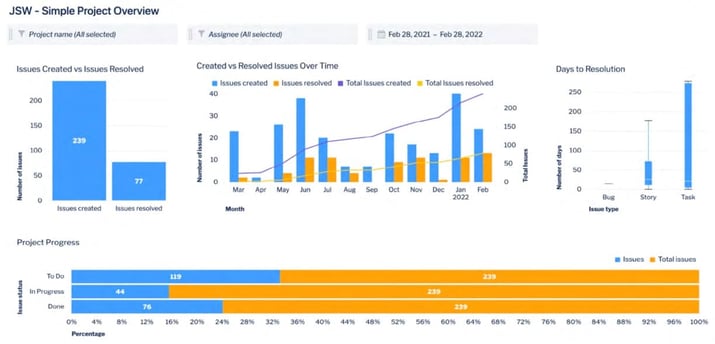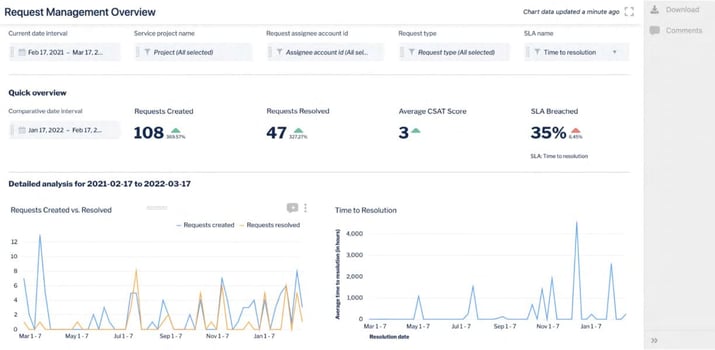Given our reliance on technology as a species, data has become one of our most prized possessions. For businesses, analyzed data is make or break, as it drives strategic decisions, fuels innovation, and provides the insights needed to stay ahead in a competitive market.
With the increasing complexity of teamwork and projects, it has become essential to harness the data generated within workflows. Where do teams invest a lot of time? Where are bottlenecks, and what impact do they have on a company's performance? Data helps us gain a comprehensive overview and define data-driven actions that guide us toward success.
Atlassian has recognized the power of data and has introduced a platform that enables intuitive data analysis, effectively putting an end to the problem of teams spending more time analyzing than gaining insights.
With Atlassian Analytics, Enterprise Cloud customers of Jira Software, Jira Service Management, and Confluence can collect, visually analyze and transform data from all team activities and projects into insights, improving collaboration and accelerating goal achievement.
What is Atlassian Analytics?
Atlassian Analytics is a Cloud-based visualization platform that processes data in various formats and consolidates it into dashboards.
The necessary information is extracted from the Atlassian Data Lake, a database containing pre-modeled, enriched data from Atlassian products used within the organization. Once the data is set up, teams can create interactive and easily customizable charts and gain a comprehensive overview of their projects and workflow through a user-friendly low-code/no-code interface.
Key features of Atlassian Analytics
Real-time data visualization
With Atlassian Analytics, projects can be monitored in real-time, and data can be presented in meaningful graphics. This allows for early trend detection, timely responses to unfavorable developments, and course corrections. The visualization options are highly versatile, with data being represented in tables, pie charts, bar charts, and numerous other formats, making it easily understandable and suitable for the intended use and audience.Pre-built templates for various use cases
Customized data analysis
Integration of database connectors
Historical data analysis
Efficient collaboration
Atlassian Analytics supports team collaboration. Team members can embed content, add comments, and manage permissions, facilitating the sharing of insights and promoting collaboration throughout the organization.
How does Atlassian Analytics work?
Atlassian Analytics speeds up decision-making at all levels. Businesses gain a complete insight into their teams' workflow and have the ability to create interactive dashboards to reduce misinterpretations and break down silos across teams and products.
Use case: Development leaders and product owners can access dashboards that provide information on the number of issues created and closed, average processing time, the current status of open issues, and associated risks.
These dashboards offer a comprehensive overview of all projects and allow for a detailed examination of specific project information, which is especially important when there is an unusual or unexpected data drop. In such cases, analysts or product managers can be tagged in a comment and are immediately involved in solving the problem.
In this way, Atlassian Analytics identifies bottlenecks and recognizes teams that may be overloaded.

Here is how teams gain complete insight into their projects and workflow with Atlassian Analytics:
1. Select data sources
Atlassian Analytics seamlessly accesses the Atlassian Data Lake, where teams can choose their desired data sources. This flexibility allows them to specify precisely from which products and instances they want to retrieve data.
They can include or exclude projects (such as Jira Software, Jira Service Management, and Opsgenie), assets, or areas (like Confluence) according to their needs.
Administrators can also set up multiple connections to the Data Lake to meet the requirements of different teams.

2. Get started with pre-built templates
Once a connection to a product instance is established, a world of pre-built dashboards and charts becomes available. These pre-built templates are specifically designed to meet the needs of both business and IT teams.
Use case: Service managers can access pre-built dashboards to assess created and resolved requests, the average CSAT score, the percentage of SLA violations, and more.
They can investigate service quality by identifying all incidents and the average time to resolution. They can also delve into the quality of specific services.

No template fits? Pre-built dashboards can be customized to meet the individual needs of teams. Users have the option to create personalized dashboards according to their preferences, whether it's renaming fields, removing charts, or rearranging elements.
3. Run SQL based on custom preferences
By running SQL queries directly in Atlassian Data Lake, it's possible to create completely custom dashboards and charts across various products or instances.
Not familiar with SQL? Visual SQL allows you to create custom charts and dashboards without code and programming skills by quickly and easily adding columns, filters, and intuitive connections between records. If additional precision is required, the option to switch to written SQL queries is available to fine-tune queries and dive deeper into the data.
Use case: Technical teams can use visual query to pull in stories and bugs assigned to them from Jira Software alongside any change requests or incidents from Jira Service Management to assess where they should prioritize their time or understand the correlation between features delivered and incident requests generated.

4. Explore various visualization options
With Atlassian Analytics, teams have the choice of a wide range of chart types and graphics to best meet their visualization needs.
Atlassian Analytics recommends a chart type based on the queried and transformed data that most effectively represents it.
5. Comment, download, and embed
Atlassian Analytics dashboards and charts are inherently collaborative and promote teamwork.
Users can add comments to charts and mention colleagues with questions or remarks. Additionally, dashboards and charts can be easily shared by embedding them in Confluence pages using Smart Links. This enables even more comprehensive collaborative analysis with different teams within the organization.

6. Integrate your own data and dive deeper
Data from Atlassian products becomes more powerful when combined with other critical business data sources. Together, they offer deeper insights into projects and the ability to align performance with business outcomes.
With combined analysis, leaders can be confident in making informed decisions based on comprehensive insights.
Use case: Teams can retrieve customer NPS ratings from the CRM and visualize this metric alongside data on incident resolution from Jira Service Management to assess how improvements in service quality impact customer satisfaction.
Similarly, growth data from a Snowflake database or Google Sheets can be incorporated alongside Jira Software data on engineering performance to evaluate how innovations affect revenue goals.
Atlassian Analytics is more than just a data analysis tool
Atlassian Analytics is a crucial step toward data-driven efficiency. All relevant sources and data, both cross-team and project, converge in one place and can be simultaneously exported to other preferred business intelligence tools through various database connections, where they can be visualized.
The platform provides insights that can be of great value to every department, from business to service to IT.
Published: Oct 11, 2023
Updated: Nov 18, 2024


.png?width=200&name=Atlassian-Cloud-Pillar-page%20(1).png)